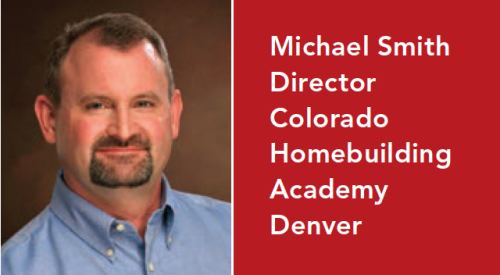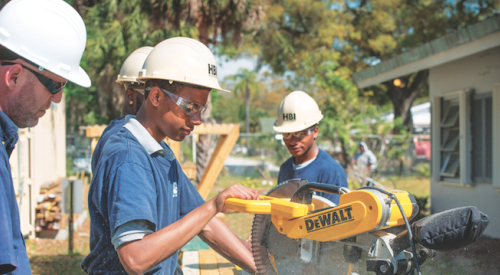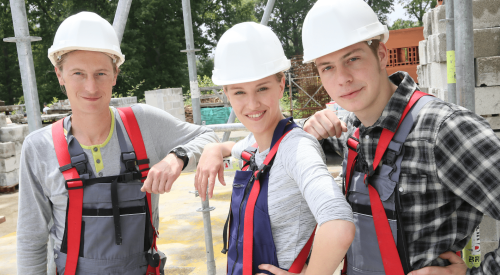Young adults who could easily have been swallowed up by the criminal justice system are getting a second chance through Casa Verde Builders in Austin, Texas. Casa Verde is a program of the nonprofit organization American Youth Works, whose founder and CEO, Richard Halpin, has worked with at-risk youth for 25 years.
"While they’re building a home, which is a metaphor for their lives, I want them to learn the skills to be self-sufficient, responsible and capable," says Halpin. "I want them to have a job skill, and I want them to be able to be the kind of workforce asset to the construction industry that goes to the leading edge."
Halpin founded American Youth Works, formerly known as the American Institute for Learning, 25 years ago. He started Casa Verde in 1995, believing that young, at-risk adults fail because they don’t get enough real-world challenges: "The idea was that young people could take on a pretty rigorous challenge and do a good job," he says. "We’ve always been interested in sustainability, and when it came to housing, our thought was, why couldn’t young adults—particularly those who hadn’t done well previously—build affordable, energy efficient, smart homes? It was a pretty sizable task, but I had confidence."
With Habitat for Humanity as its first building partner, Casa Verde hired two experienced builders to manage the project and do the training. "They worked every day with the toughest kids we could find, and they inspired and encouraged them," Halpin says. "If it wasn’t right, we tore it out and did it over. The first house took us a year. We had five young people with pretty profound challenges in their lives, [including] substance abuse, and it was hard to get them to come every day and focus."
This first project and crew faced more than just a little adversity in completing construction. In fact, some attic insulation caught fire and the house burned down. But, says Halpin, no one wanted to abandon the project, and the home was rebuilt.
In 1996, Casa Verde received a grant from AmeriCorps, a program of the Corporation for National Service that was started by former President Bush’s Points of Light legislation. Funding was also provided by the HUD YouthBuild program, which allowed Halpin to be able to hire 15 builders instead of two and accept 50 trainees instead of five. "That year we rose like the phoenix from the ashes and built five houses."
Since its inception, Casa Verde has built 60 houses and trained 300 young adults. Positive word of mouth and a host of local and national awards have increased the program’s visibility. AmeriCorps and YouthBuild award grants to Casa Verde nearly every year, and there are also private-sector contributors such as Dell Computers and Home Depot. "Home Depot has been a big contributor and partner," Halpin says. "They bring a lot of their folks out to see the materials we use and try out their new air guns and laser levels, and when they’re done they leave [the tools behind for us.]"
By building high-quality new homes for low-income buyers, Casa Verde has helped revitalize several distressed neighborhoods in Austin. "The graffiti’s gone, the burned-out houses have been fixed up and the drug dealers and prostitutes are gone," he says. "Now the neighborhoods are pleasant places to live."
Casa Verde has won accolades for its energy and resource-efficient homes. Halpin says the city of Austin has documented a 30 to 40 percent reduction in energy costs, compared to conventional homes. A typical single-family home is 1100 square feet with three bedrooms and two baths, and uses structural insulated panels (SIPs) for the exterior wall system to provide continuous R-16 insulation unbroken by studs. The exterior is usually clad in Hardipanel or Hardiplank fiber-cement siding, which helps keep maintenance and repair costs down.
Sustainability is further enhanced by the use of steel studs, recycled steel roofing, concrete foundations with a high percentage of fly ash and a deck material made from cedar chips and recycled plastic bags that never needs replacing. The kitchen cabinets are built by Casa Verde using formaldehyde-free, medium-density fiberboard, and all interior paints have a low-VOC content. Always on the lookout for innovative technologies, Casa Verde recently installed a geothermal heating system in one home, and is in the process of building a straw-bale house.
Most training is done on the job site, but there is a certain amount of class work as well. Those who have not finished high school can get the classroom instruction they need in a charter high school set up by Casa Verde. "In turn, we can give them credit for some of the applied learning they do," Halpin says. "We teach math and other credit classes out at the project site." The trainees, who are paid minimum wage, are dual-enrolled in the local community college so that they can earn college credits at the same time they’re learning to be builders.
Thanks to funding from AmeriCorps, every trainee who stays in the program at least six months earns a $2,400 scholarship that can only be used for college or training school. Those who stay in the program for two years (the maximum allowed) can earn nearly $10,000 in scholarship money.
"It’s a real win-win-win situation, and when you team that up with employers who are always looking for good employees, it’s a win to the fourth power because employers are getting people who are reliable," he says. "We really work on life skills—being on time, being responsible, getting along with people, being a good team member—things you have to have on a construction job."
Graduates of the program go on to work for home builders, electricians, plumbers and building supply retailers. "Some want to be architects, some want to be contractors," says Halpin. "Austin’s housing industry is going as fast as it can, and to have young people like this who are able to be part of the workforce is really a big help."
Also See:
Technology’s Fast Track
Better Houses
Life Lessons
Sustainable Partners











